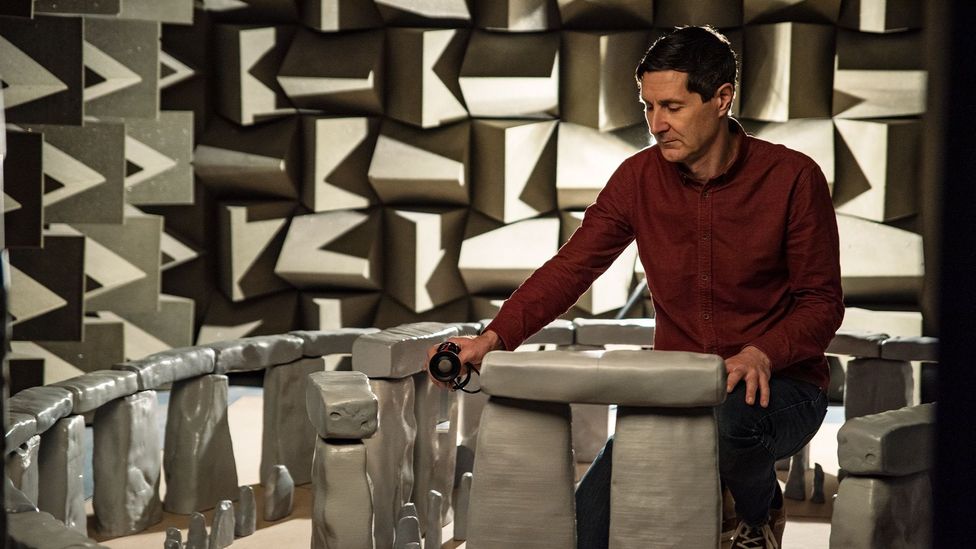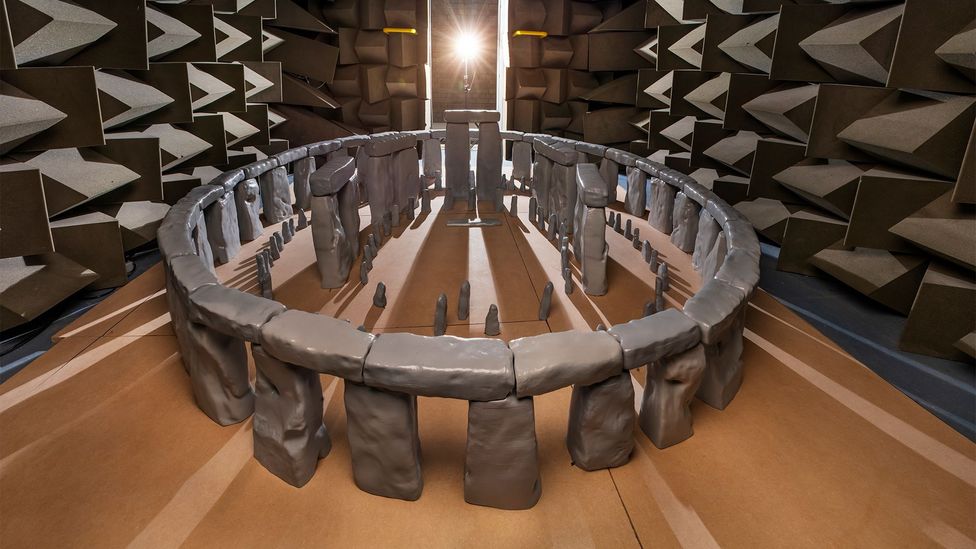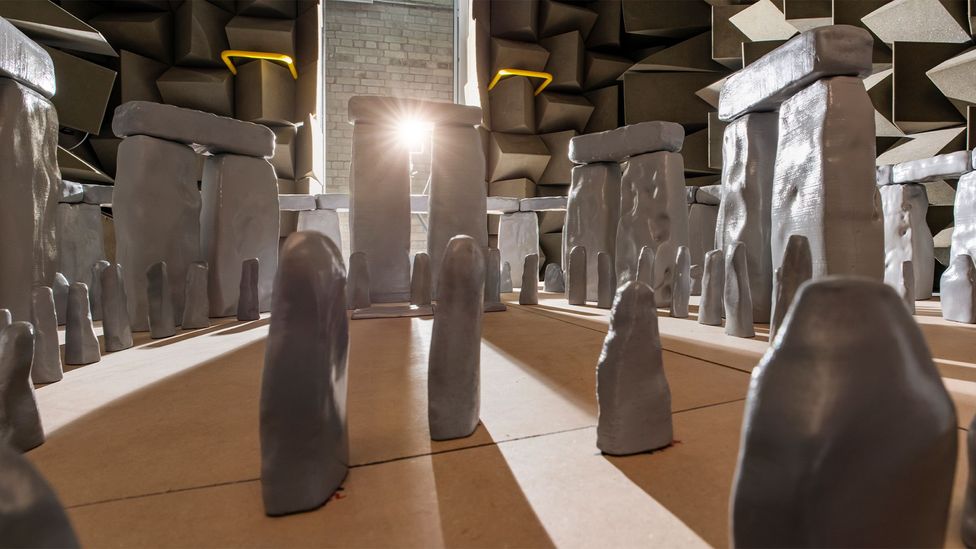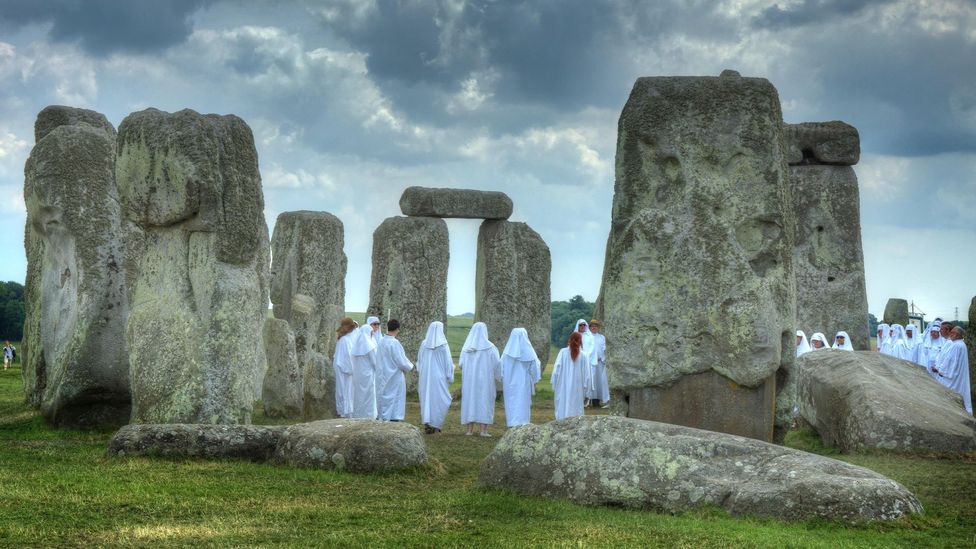Through the doors of a university building, down a concrete hallway and inside a foam-covered room stands a shin-high replica of one of the most mysterious monuments ever built: Stonehenge.
These miniature standing stones aren’t on public display, although they might help give the million annual visitors who come to the real site a better understanding of the imposing, lichen-covered stone structure built roughly 5,000 years ago. Instead, this scale model is at the centre of ongoing research into Stonehenge’s acoustical properties, and what its sound might tell us about its purpose.
“We know that the acoustics of places influence how you use them, so understanding the sound of a prehistoric site is an important part of the archaeology,” said Trevor Cox, professor and acoustics researcher at the University of Salford in Manchester.

Professor Trevor Cox believes that understanding Stonehenge’s acoustical properties could shed light on its mysterious use (Credit: Andrew Brooks)
Despite being the world’s best-known and most architecturally sophisticated ancient stone circle, archaeologists still don’t know who built Stonehenge or what it was used for. Some theories suggest it was used as a burial site, a place of healing or even a celestial calendar, given that the gaps in the outer stone ring are in perfect alignment with the summer and winter solstice. Yet as the decades pass, this massive monument built on a grassy hill in the Wiltshire countryside remains a mystery.
“We’re gradually finding out more and more about it, but some things we just don’t think we’ll ever be able to find out. We have no way of understanding why people started to build it, and the reason that they continued to work on it may well have changed over the hundreds of years it took to complete,” said Susan Martindale, volunteer manager for English Heritage, the charitable trust that manages Stonehenge.
Thanks to Cox’s recent studies, however, we now know a fascinating detail about one of the world’s most enigmatic sites: it once acted as a giant echo chamber, amplifying sounds made inside the circle to those standing within, but shielding noise from those standing outside the circle. This finding has led some to ponder whether the monument was actually constructed as a ritual site for a small and elite group.
This breakthrough is a decade in the making. While researching “the sonic wonders of the world” 10 years ago, Cox began to ponder whether studying the acoustical properties of Stonehenge may help uncover some of its secrets. “I realised there was a technique in acoustics that had never been applied to prehistoric sites before, and that was acoustic scale modelling,” he said. “I’m the first to make a scale model of Stonehenge or any prehistoric stone site.”
Cox set out to create a 1:12 scale replica that he could test inside the university’s semi-anechoic chamber, a room that absorbs virtually all sound, thanks to the geometric foam covering every surface except the floor. To create the replica, Cox first received a computer model from English Heritage, allowing him to better understand what Stonehenge looked like at its fullest configuration, around 4,000 years ago.
“If you go down to modern Stonehenge, it’s a magnificent site, but a lot of the stones are missing or lying on the floor,” he said. “This [configuration] is one particular arrangement. Actually, from about 2000 BCE onwards, it changed a lot for about a millennium.”
In total, the process of creating 157 stones through 3D printing and moulding techniques took about six months to complete. During that time, Cox said his dining room floor was covered with bits and pieces of the project in a laborious effort to achieve the qualities of real stones at scale.
Once the stones were painted grey and arranged in the correct distribution according to the computer model, the challenges of the testing process began. “Everything’s a twelfth of the size in real life, and that means we have to test at 12 times the frequency,” he said. “You have to get all the loudspeakers and microphones that work at those frequency ranges and they’re not commonly available.”

Cox has recreated a 1:12 scale replica of how Stonehenge once appeared (Credit: Andrew Brooks)
To complete each test, Cox and his team placed the loudspeakers around the stones and played the various frequencies they were interested in measuring. The microphones in the room collected data on how the stones affected the sound. Through mathematical processing, Cox was able to create a computer model that simulates the acoustic properties of Stonehenge and can distort voices or music to give a sense of what they would sound like within the circle. The results surprised him: although Stonehenge has no roof or floor, sound bounces between the gaps in the stones and lingers within the space. In acoustics, lingering sound is known as reverberation.
“We know that music is improved by reverberation, so we would imagine if music was played, it would just sound a little bit more powerful and impactful within the circle,” he said.
One of the most notable findings from Cox’s research is the effect of the stones on the directionality of the voice. In an open, natural environment, like the grassy hill Stonehenge is built on, a speaker facing away from a listener would only be understood about one-third of the time. The reflections from the stones at Stonehenge would have amplified the voice by four decibels, bringing the number of sentences understood to 100%.
These results showed that Stonehenge would have allowed people inside the circle to hear each other quite well, while those outside would have been excluded from any ceremonies taking place. Cox’s research adds to a growing body of evidence that Stonehenge may have been used for rituals reserved for a select few, with one study even pointing to the possibility of a hedge grown to shield the view from those not participating.

Cox has found that Stonehenge once acted as an echo chamber, leading some to believe it was a ritual site for those belonging to an elite inner circle (Credit: Andrew Brooks)
“The research definitely gives more information about how Stonehenge might be used. Even if you turn away, there’s always stone reflections to reinforce your voice, so it doesn’t really matter if you can’t see the person talking. It would be quite good for speech communication,” he said.
Cox likens Stonehenge’s acoustical properties to the difference between standing in an empty cinema as opposed to a cathedral. Although those of us used to going in and out of buildings might not find the difference very discernible, Cox notes that the late Neolithic people who built Stonehenge and weren’t used to the acoustics of large walls and enclosed spaces would have likely found the effect mesmerising.
After Cox published his initial findings in 2020, he and his colleagues began to tackle new questions, such as how people inside the circle might change the acoustics. The team recently finished a new set of measurements by placing up to 100 small, wooden figurines around the model.
“We know that people being inside would have changed the acoustics because we absorb sound,” he said. “We want to quantify how it might have changed as more people went inside the circle, because presumably there were people inside the circle during the ceremonies.”

Cox’s findings suggest Stonehenge may have been used for important ceremonies (Credit: marc zakian/Alamy)
This latest research also takes a closer look at how listeners hear sounds coming from different angles, since whether sound reaches people from the side or front changes how we perceive it. For example, sound reflections from the side improve the quality of music in a concert hall. Once Cox analyses his new set of data, he hopes to publish the findings later this year.
Cox acknowledges that unanswered questions about the real Stonehenge make it difficult for him to draw definitive conclusions from his work with the scale model. Instead, he sees the acoustics research as another tool to find more clues and build a clearer picture of the site’s qualities.
The problem with acoustic archaeology is that sound disappears, so we can’t ever be certain about what was done there
“If we think about human ceremonies, they usually involve some form of sound, whether that’s music or speaking or chanting. And we know that if they really wanted to be heard, people should have been inside the circle,” he said. “Now, the problem with acoustic archaeology is that sound disappears, so we can’t ever be certain about what was done there.”
Although Cox’s day-to-day work focuses on improving sound for those with hearing loss, he now regularly fields requests to discuss his Stonehenge research.
“One of the things about working on it is you realise how powerful it is to people, how people really connect with it and how people are fascinated by anything to do with Stonehenge,” he said. “I think that creates a mystique for the amazing ability of our ancestors to create the most astonishing monuments.”
Source: BBC Travel


